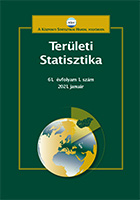A települési lélekszám differenciáló szerepe: A hazai „települési lépcső” történeti vizsgálata, 1720–1910
Differentiation of the Hungarian settlement network in light of the population number: A historical analysis of the ‘settlement ladder’, 1720–1910
Author(s): György MikleSubject(s): History, Social Sciences, Economy, Geography, Regional studies
Published by: Központi Statisztikai Hivatal
Keywords: settlement network; settlement hierarchy; regional disparities; historical geography
Summary/Abstract: Geographical analysis of the current Hungarian settlement network has shown that the population number and local social and economic structures are interrelated. Indices of demography, local labour market, income level, level of education, structure of local economic production are some of the dimensions correlating with the population number. The role of population size has been analysed intensively in the case of the smallest villages (usually defined as villages below 500 inhabitants); these settlements have been facing a complex set of issues, at least from the last third of the 20th century.The current paper is focusing on the changing role of population size between 1720 and 1910 in the territory of pre-World War I Hungary. Based on settlement level data, some major characteristics of local social and economic structures are analysed, in order to shed light on the interconnectedness of the population number and geographical disparities, using quantitative methods. Main questions to be answered are the following: (1) has the role of settlement size changed throughout the 18th and 19th centuries and in what way? (2) could the role of regional/geographical disparities or rather the role of settle-ment size be considered more important? (3) is it possible to delimit certain settlement types based on their size in the analysed period? By answering these questions, the research might contribute to the analysis of historical geographical disparities, and provide additional considerations to the research focusing on the recent processes of rural areas.It is shown that the ‘settlement ladder’ can be detected both in the 18th and in the early 20th century. Even if the regional differentiation of the settlement network was significant, the role of the settlement size is evident as well. In the 18th century the smallest villages (those under 100 inhabitants), the villages between 100 and 2000 inhabitants and the towns above 10 000 inhabitants could be distinguished, while in 1910 the smallest (under 100 inhabitants), and the settlements above 50 000 inhabitants could be characterised by specific indices.
Journal: Területi Statisztika
- Issue Year: 63/2023
- Issue No: 03
- Page Range: 381-420
- Page Count: 40
- Language: Hungarian

